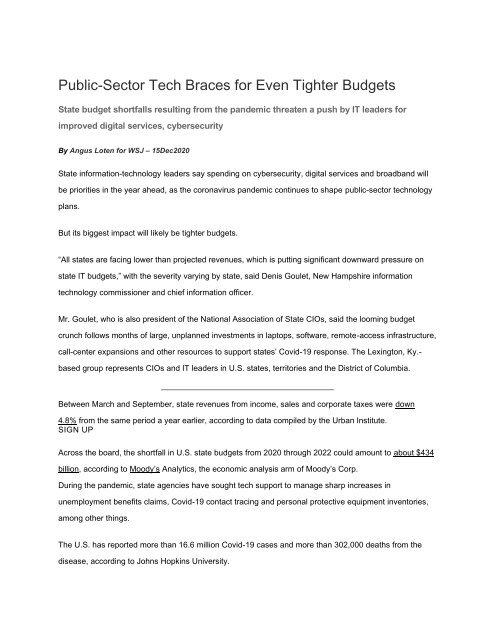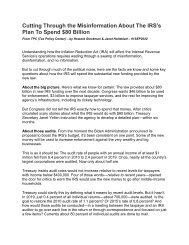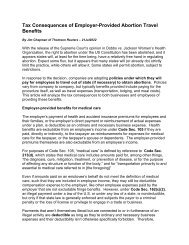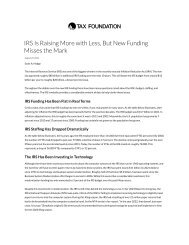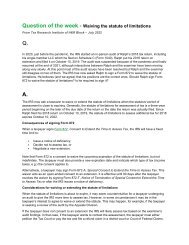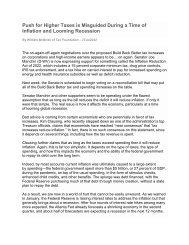Create successful ePaper yourself
Turn your PDF publications into a flip-book with our unique Google optimized e-Paper software.
<strong>Public</strong>-<strong>Sector</strong> Tech Braces for Even Tighter <strong>Budget</strong>s<br />
<strong>State</strong> budget shortfalls resulting from the p<strong>and</strong>emic threaten a push by IT leaders for<br />
<strong>improved</strong> <strong>digital</strong> <strong>services</strong>, <strong>cybersecurity</strong><br />
By Angus Loten for WSJ – 15Dec2020<br />
<strong>State</strong> information-technology leaders say spending on <strong>cybersecurity</strong>, <strong>digital</strong> <strong>services</strong> <strong>and</strong> broadb<strong>and</strong> will<br />
be priorities in the year ahead, as the coronavirus p<strong>and</strong>emic continues to shape public-sector technology<br />
plans.<br />
But its biggest <strong>impact</strong> will likely be tighter budgets.<br />
“All states are facing lower than projected revenues, which is putting significant downward pressure on<br />
state IT budgets,” with the severity varying by state, said Denis Goulet, New Hampshire information<br />
technology commissioner <strong>and</strong> chief information officer.<br />
Mr. Goulet, who is also president of the National Association of <strong>State</strong> CIOs, said the looming budget<br />
crunch follows months of large, unplanned investments in laptops, software, remote-access infrastructure,<br />
call-center expansions <strong>and</strong> other resources to support states’ Covid-19 response. The Lexington, Ky.-<br />
based group represents CIOs <strong>and</strong> IT leaders in U.S. states, territories <strong>and</strong> the District of Columbia.<br />
Between March <strong>and</strong> September, state revenues from income, sales <strong>and</strong> corporate taxes were down<br />
4.8% from the same period a year earlier, according to data compiled by the Urban Institute.<br />
SIGN UP<br />
Across the board, the shortfall in U.S. state budgets from 2020 through 2022 could amount to about $434<br />
billion, according to Moody’s Analytics, the economic analysis arm of Moody’s Corp.<br />
During the p<strong>and</strong>emic, state agencies have sought tech support to manage sharp increases in<br />
unemployment benefits claims, Covid-19 contact tracing <strong>and</strong> personal protective equipment inventories,<br />
among other things.<br />
The U.S. has reported more than 16.6 million Covid-19 cases <strong>and</strong> more than 302,000 deaths from the<br />
disease, according to Johns Hopkins University.
Online <strong>services</strong>, such as driver’s license renewals or accessing public-health information, jumped two<br />
places this year to rank second in the annual listing of state IT priorities compiled by NASCIO. Broadb<strong>and</strong><br />
access climbed to the fourth spot, its highest ever ranking, driven by increased dem<strong>and</strong>s to support<br />
remote work, home schooling <strong>and</strong> other issues sparked by lockdowns <strong>and</strong> travel restrictions.<br />
Cybersecurity topped the list for the ninth year in a row, the group said. The rankings are determined by<br />
member votes.<br />
Throughout the year, many public-sector IT leaders were forced to balance ongoing efforts to update<br />
aging systems with emergency needs.<br />
Recent shifts to cloud computing helped carry the added load without overwhelming available capabilities,<br />
while enabling agencies to rapidly deploy communications <strong>and</strong> collaboration software <strong>and</strong> other<br />
applications.<br />
“<strong>Public</strong>-sector agencies will have to continue the migration to the cloud to accommodate their work-fromhome<br />
staff,” said Daniel Castro, vice president of the Information Technology <strong>and</strong> Innovation Foundation,<br />
a Washington-based tech policy think tank.<br />
Mr. Castro said a breach earlier this year of computer systems at multiple federal agencies, disclosed this<br />
week, will likely focus greater attention on state IT security efforts.<br />
The attacks, which included the U.S. Treasury <strong>and</strong> Commerce departments, are believed to be part of<br />
a global cyber-espionage campaign targeting key public-sector agencies.<br />
While cyberattacks typically exploit security weaknesses or poorly guarded systems, he said,<br />
“organizations with good security practices still fell victim.” Mr. Castro said the attack could prompt some<br />
public IT security leaders to adopt strategies such as a zero-trust model, which involves narrowing<br />
<strong>cybersecurity</strong> efforts to the level of individual applications, rather than an entire network—a safer, but<br />
costly shift.<br />
New Hampshire's Mr. Goulet said security breaches <strong>and</strong> ransomware attacks hamper the ability for state<br />
<strong>and</strong> local governments to provide essential <strong>services</strong>, including p<strong>and</strong>emic-relief efforts.<br />
“Almost every day we’re reminded that we must remain ever vigilant,” he said. “No one is immune.”


